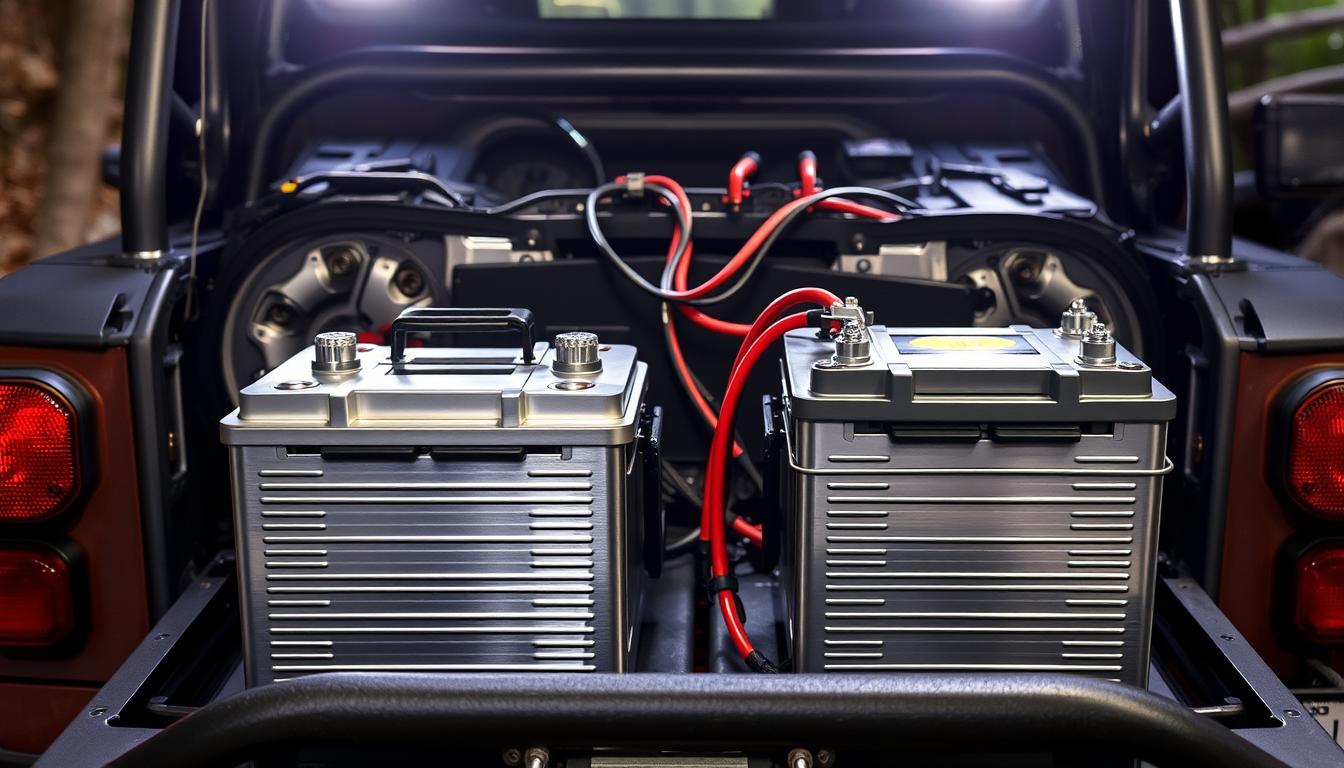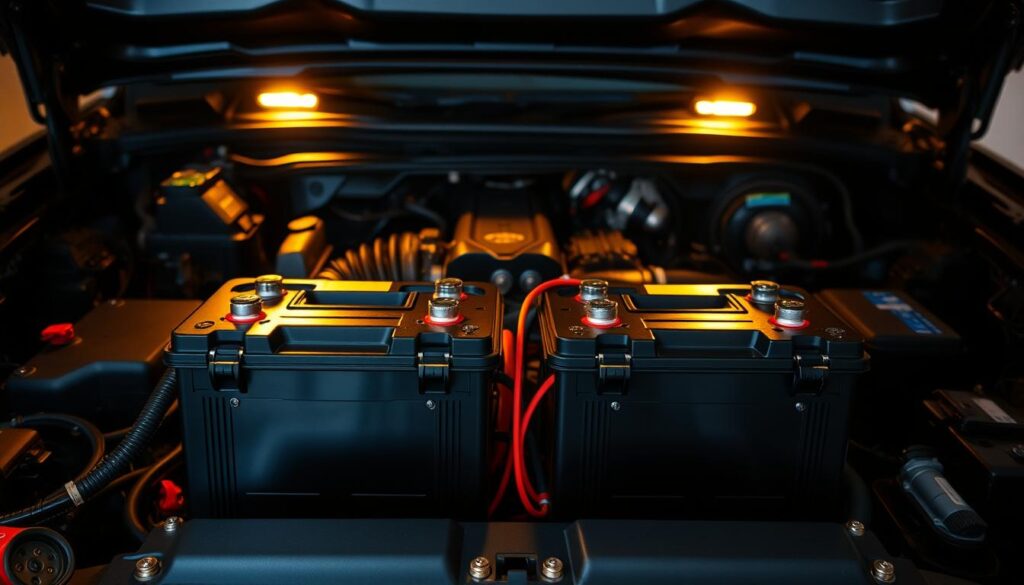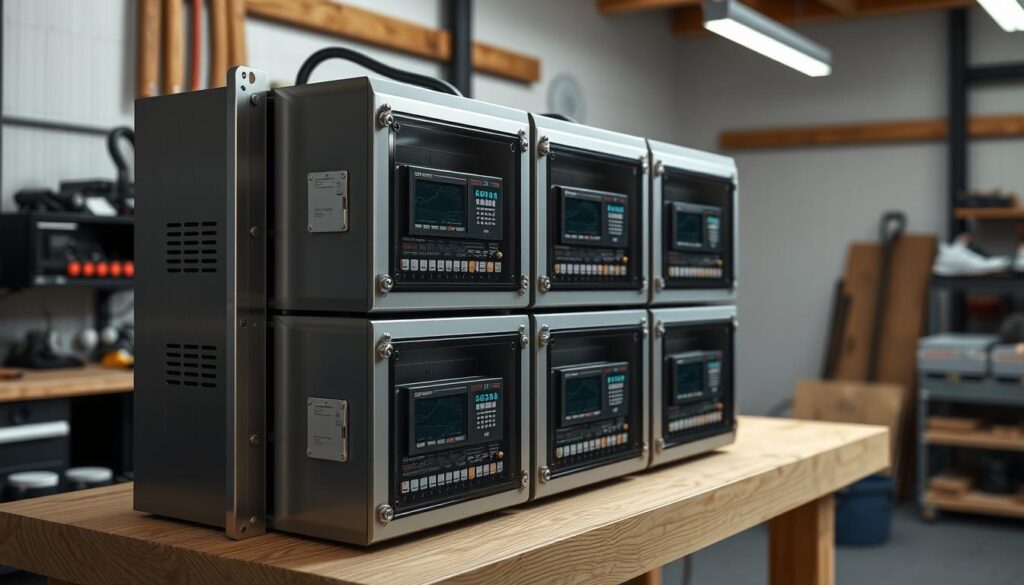How to Install a Dual Battery System in Your 4×4

A dual battery setup is key for many 4x4s. It gives more power for accessories and makes long off-road trips safer.
Exploring the Australian outback? A strong 4×4 electrical system is vital. A dual battery system keeps your main battery for starting. The second battery powers extras like lights, radios, and fridges.
This setup makes your vehicle’s electrical system more reliable. It also gives you peace of mind on long trips.
Key Takeaways
- Understand the benefits of a dual battery setup for 4×4 vehicles.
- Learn how to choose the right batteries for your dual battery system.
- Discover the importance of a robust 4×4 electrical system.
- Find out how to install a dual battery system safely and efficiently.
- Gain insights into maintaining your dual battery setup.
Understanding the Benefits of a Dual Battery System
Adding a dual battery system to your 4×4 boosts its electrical power. This makes off-grid adventures more fun. It gives a steady and efficient power supply, key for 4×4 trips.
Dual battery systems offer many benefits. They improve your vehicle’s performance and reliability. A big plus is supporting extra accessories without using up the main battery.
Increased Power for Accessories
A dual battery system lets you power many accessories. This includes winches, fridges, and comms gear. It’s great for 4×4 power management, giving power for both vehicle needs and extra gear.
For example, winches need a lot of power. With a dual system, you can use your winch without harming your main battery. This is perfect for off-grid trips where charging is hard to find.
Extended Battery Life
Distributing power between two batteries makes them last longer. This is because neither battery is always fully loaded. Regular vehicle dual battery system care is key, keeping both batteries charged and in good shape.
| Benefit | Single Battery System | Dual Battery System |
|---|---|---|
| Battery Life | Shorter due to full load | Longer due to load distribution |
| Power for Accessories | Limited, risking primary battery | Ample, without risking primary battery |
| Reliability | Lower, as failure affects all systems | Higher, as backup battery ensures continuity |
Improved Reliability
Dual battery systems make your vehicle more reliable. If one battery goes out, the other keeps things running. This is vital for dual battery setup users in remote areas.
Reliability is key when you’re far from home. A dual battery system gives you peace of mind, knowing you’re covered in emergencies.
Essential Tools and Materials
To install dual batteries in your 4×4, you need the right tools and materials. This makes the installation smooth and ensures a reliable system.
Tools You’ll Need
Having the right tools is key for a successful install. Here’s what you’ll need:
- Wrench Set: For loosening and tightening battery terminals and other components.
- Pliers and Wire Cutters: For cutting and stripping wires to the correct length.
- Screwdrivers: Both flathead and Phillips screwdrivers are necessary for various parts of the installation.
- Multimeter: To check voltage and ensure the system is functioning correctly.
- Drill and Bits: If you need to mount additional components or secure wiring.
Suggested Battery Brands
Choosing the right batteries is vital for your dual battery system’s performance and longevity. Here are some top brands:
| Brand | Battery Type | Warranty |
|---|---|---|
| Optima | AGM | 3 Years |
| Exide | Lead-Acid | 2 Years |
| RedArc | AGM | 2 Years |
Additional Accessories
Several accessories are needed to complete your dual battery system:
- Battery Isolator: Ensures that both batteries are charged correctly and prevents the primary battery from draining.
- Heavy-Duty Cables: For connecting the batteries to the electrical system.
- Fuse Holder and Fuses: To protect the electrical system from overloads.
- Battery Monitor: To keep track of the state of charge and health of your batteries.
With these tools and materials, you’re ready to install a reliable dual battery system in your 4×4. It will enhance its capability and your adventure experience.
Choosing the Right Battery Setup
It’s important to know the different batteries available for your 4×4’s electrical system. The right battery setup can greatly improve your vehicle’s performance and reliability, even when you’re off the grid.
Types of Batteries: AGM vs. Lead-Acid
For dual battery systems, you’ll often see two types: Absorbent Glass Mat (AGM) batteries and Lead-Acid batteries. AGM batteries are durable and handle vibrations well, perfect for 4x4s on rough terrain.
Lead-Acid batteries are more traditional and cheaper at first. But, they need more upkeep than AGM batteries.
- AGM Batteries:
- Maintenance-free
- Resistant to vibration
- Deep cycle capability
- Lead-Acid Batteries:
- Lower upfront cost
- Wide availability
- Well-established recycling infrastructure
Evaluating Your Power Needs
To pick the right battery setup, you must assess your power needs. Think about your 4×4’s electrical needs, including winches, fridges, or lights.
- List all electrical components and their power consumption.
- Calculate the total power required.
- Consider how long you need to power these without recharging.
Understanding your power needs helps you choose a battery setup that meets your demands. This ensures your 4×4 works when you need it most.
Planning Your Installation
Installing a dual battery system in your 4×4 needs careful planning. This ensures your vehicle’s electrical system works well and your batteries last longer.
Selecting the Ideal Location
Finding the perfect spot for the second battery is key. It should be in a cool, dry place, away from sunlight. Think about the space and how easy it is to get to for upkeep.
- Make sure it’s safe and won’t get damaged by shakes.
- Keep it away from important parts to avoid problems.
Wiring Considerations
Good wiring is vital for your dual battery system to work right. Use top-notch cables that fit your system’s needs.
| Cable Size | Application |
|---|---|
| 4 AWG | High current applications |
| 6 AWG | Standard dual battery setups |
| 8 AWG | Lower current needs |
Always check the manufacturer’s guidelines for the best wiring advice.

Good planning and doing things right are essential for a great dual battery setup. By picking the right spot and thinking about wiring, you’ll get a 4×4 power system that works well.
Step-by-Step Installation Guide
Installing a dual battery system is great for 4×4 fans who need extra power. This guide will help you set it up safely and right.
Disconnecting the Primary Battery
First, disconnect the primary battery to avoid electrical issues. Make sure your vehicle is turned off and in neutral gear. Then, do the following:
- Remove the negative (black) cable from the primary battery.
- Secure the cable to prevent it from coming into contact with the battery terminal.
Installing the Second Battery
Choosing the right spot for the second battery is key. It should be close to the primary battery and well-ventilated. Once you’ve picked the best place:
- Mount the second battery securely using the right brackets.
- Make sure the battery terminals are easy to wire.
Connecting the Batteries
Connecting the batteries right is essential for safety and function. You can use a parallel battery isolator or a battery management system (BMS). Here’s a quick guide:
| Component | Description | Connection Point |
|---|---|---|
| Battery Isolator/BMS | Manages charge distribution between batteries | Primary Battery Positive Terminal |
| Second Battery | Additional power source | Connected to Primary Battery via Isolator/BMS |
A leading auto electrician says, “A well-installed dual battery system greatly lowers electrical failure risks. It’s perfect for 4x4s with lots of accessories.”
“A well-installed dual battery system is not just about added power; it’s about reliability and peace of mind on the trail.”
By following these steps and making sure all connections are secure and insulated, you’ll get a working dual battery system. It will boost your 4×4’s power.
Incorporating a Battery Management System
For 4×4 fans, a Battery Management System is key. It helps manage and protect dual battery setups. A BMS keeps an eye on charging and discharging, making sure batteries stay safe.
What is a Battery Management System?
A Battery Management System (BMS) is an electronic system for rechargeable batteries. It’s used in 4×4 dual battery systems. It stops batteries from going outside safe limits, checks their state, and balances them.

Advantages of Adding a BMS
Adding a BMS to your 4×4 dual battery system has many benefits. Here are a few:
- Enhanced Battery Life: A BMS stops overcharging and deep discharging. This makes batteries last longer.
- Improved Performance: A BMS keeps batteries in top shape. This boosts your 4×4’s electrical system performance.
- Increased Safety: It lowers the chance of battery failure. This is important when you’re off-grid.
| BMS Feature | Benefit |
|---|---|
| Overcharge Protection | Prevents battery damage from excessive charging |
| Deep Discharge Protection | Stops batteries from being overly discharged, preserving their lifespan |
| State of Charge Monitoring | Provides real-time data on battery health and charge levels |
Adding a BMS to your 4×4’s dual battery system is smart. It makes your vehicle’s power management reliable and efficient. Knowing how a BMS works helps you get the most out of your 4×4’s power system.
Safety Precautions During Installation
When you’re working with electrical systems, safety is key. Installing a dual battery setup in your 4×4 is no exception. If done wrong, it can lead to injuries or harm your vehicle’s electronics.
Working With Electricity Safely
It’s vital to follow safety rules when dealing with electrical work. Always disconnect the battery before starting. This prevents short circuits. Use insulated tools to avoid electrical shock. Make sure your workspace is well-lit and clear of clutter.
- Wear protective gear like gloves and safety glasses.
- Make sure your tools are in good shape and right for electrical work.
- Don’t work on electrical systems when you’re tired or distracted.
Protecting Your Vehicle’s Electronics
Modern 4x4s have advanced electronics that can be damaged by electrical surges or bad installation. To keep your vehicle’s electronics safe, use high-quality wiring and connectors that fit the job. Don’t overload the electrical system. Make sure all connections are secure and well-insulated.
Following the manufacturer’s instructions for electrical components is also key. If you’re not sure about any part of the installation, get a professional’s help.
- Check the manufacturer’s guidelines for specific installation needs.
- Use fuse holders and circuit breakers to guard against overcurrent.
- Label your wiring for easier maintenance and troubleshooting later.
Testing Your Dual Battery Setup
Testing your dual battery setup is key to making sure it works right. It checks if your 4×4’s electrical system is ready for off-road trips or heavy use. This test is essential for your vehicle’s performance.
How to Check Voltage and Connections
To see if your dual battery system is working, check the voltage and connections. Use a multimeter to measure the voltage. A fully charged battery should show about 12.6 volts. If it’s lower, there might be a problem with the battery or charging system.
Checking Connections: Make sure all connections are clean, tight, and corrosion-free. Corrosion can cause voltage drops and poor charging. Clean corroded areas with a wire brush and apply a corrosion inhibitor to protect them.
Troubleshooting Common Issues
If your dual battery setup isn’t working right, there are a few common problems to look into. These include:
- Incorrect wiring or loose connections
- Battery imbalance or sulfation
- Faulty battery management system (BMS)
- Insufficient charging
| Issue | Cause | Solution |
|---|---|---|
| Low Voltage Reading | Deep discharge or faulty battery | Recharge or replace the battery |
| Overcharging | Faulty alternator or BMS | Check and replace the faulty component |
| Voltage Drop | Corroded or loose connections | Clean and tighten connections |
By following these steps, you can find and fix common problems with your dual battery setup. This ensures your 4×4 runs smoothly for all your adventures.
Maintaining Your Dual Battery System
To keep your 4×4’s dual battery system working well, regular care is essential. A good dual battery system is key for powering accessories and keeping your vehicle reliable. This is true, whether you’re off-roading or camping.
Regular Checks and Maintenance Tips
It’s important to regularly check your dual battery system’s health. First, look at the batteries’ terminals for corrosion. Clean them with a baking soda and water mix to avoid damage. Make sure all connections are tight and secure.
Also, check the batteries’ charge level often. Use a battery monitor or multimeter to see their charge and voltage. For deep cycle batteries, keep them charged over 50% to extend their life.
Maintenance Schedule:
- Check battery terminals for corrosion every 3 months.
- Inspect battery connections every 6 months.
- Monitor battery state of charge monthly.
| Maintenance Task | Frequency | Importance Level |
|---|---|---|
| Check battery terminals for corrosion | Every 3 months | High |
| Inspect battery connections | Every 6 months | High |
| Monitor battery state of charge | Monthly | High |
Signs Your Batteries Need Replacement
Batteries have a limited life, even with regular care. Look out for signs like slower engine start or dimmer lights. If your batteries are over 5 years old, get them checked by a pro.
Other signs include too much corrosion that can’t be cleaned off. Or if they’ve been deeply discharged many times. If one battery fails in a dual system, it’s wise to replace both for consistent power.
By following these maintenance tips and knowing when to replace batteries, your 4×4’s dual battery system will stay in top shape. This ensures reliable power for all your adventures.
Frequently Asked Questions About Dual Battery Systems
Thinking about a dual battery setup for your 4×4? You might have many questions. It’s important to know the facts and clear up any myths for a smooth installation.
Common Myths and Facts
Many think dual battery systems are hard to install. But, with the right guide, like our step-by-step guide, it’s doable for DIY fans. Another myth is that dual batteries will drain each other. Actually, a good system with a BMS keeps both batteries charged and healthy.
Lifespan of Dual Batteries
The life of dual batteries depends on several things. These include the battery type, how well you maintain them, and how you use them. Generally, a well-looked-after dual battery system can last 3 to 5 years. Regular checks and upkeep, as we discuss, can make them last longer.
DIY Installation Feasibility
Installing a dual battery system in your 4×4 can be a DIY project. You just need the right tools and a detailed guide. Knowing about wiring and safety is essential for a good job. By following our article, you can set up a dual battery system that fits your needs.
FAQ
What is the primary purpose of a dual battery system in a 4×4 vehicle?
A dual battery system boosts power for accessories. It makes the vehicle more reliable. It also keeps the vehicle running even if one battery fails.
What are the benefits of using an AGM battery over a lead-acid battery in a dual battery setup?
AGM batteries last longer and handle vibrations better. They also need less maintenance than lead-acid batteries.
How do I evaluate my power needs for a dual battery system?
First, add up the power needs of your accessories. This includes lights, winches, and fridges. Then, pick a battery setup that can handle that load.
What is a battery management system, and is it necessary for a dual battery setup?
A BMS monitors and protects batteries. It checks voltage, temperature, and charge levels. It’s highly recommended for a dual battery setup to ensure safe and efficient use.
Can I install a dual battery system myself, or do I need professional help?
You can install a dual battery system yourself if you know electrical systems. But, if you’re unsure, it’s best to get professional help.
How often should I check and maintain my dual battery system?
Check your dual battery system every 3-6 months. Look at battery terminals, check voltage, and make sure everything is working right.
What are the signs that indicate my dual batteries need replacement?
Look for reduced capacity, age over 5 years, and visible wear or damage. These are signs it’s time for new batteries.
How long do dual batteries typically last?
Dual batteries’ lifespan varies based on usage, maintenance, and quality. Generally, a well-kept dual battery system lasts 3 to 5 years.





